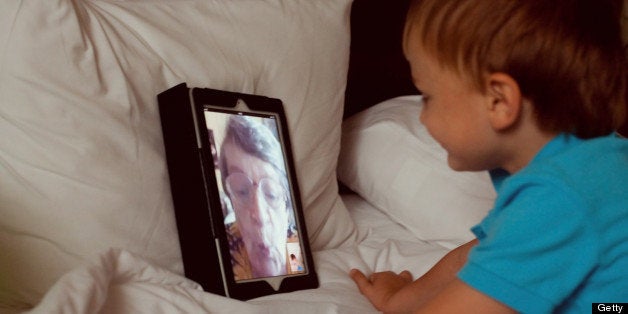
Not too long ago, technology served as a divider between generations. Parents, for example, saw their iPod-using, headphone-wearing kids as blocking themselves off from the rest of the world. And grandparents could hardly boot up a computer, much less figure out how to IM. Yet, as times have changed, we're seeing formerly "divisive" technologies connecting older and younger generations in ways never before thought possible. Look no further than mobile apps, social networks and a host of some of the hottest games like Dots, Draw Something, and Words with Friends -- they're likely to be just as popular with moms and dads as they are with teenagers.
Revisiting the famous adage by Marshall McLuhan, the "medium is still the message," and technology now sits at the center of our conversations. So with Father's Day coming up and generations around the world joining together in the exchange of sentiments and ideas, here are some ways in which innovations in communications have helped and deepen family relationships and closed the generational gap.
Always-on, cross-platform devices means no more restrictions on how or where we communicate
Let's face it. We live in a world where people not only want, but expect, immediate access to everything -- and this extends to people, not just physical items. User friendly designs like those of the iPhone and iPad have broad appeal to old and young alike, and the interconnectedness of devices and ubiquity of apps like Twitter and Facebook Messenger, which allow you to reach friends across smartphones, feature phones or desktop, has opened the door for us to be many "places" at once, nearly always available at a moment's notice.
Whether it's having a Gchat with Mom, or IMing Dad on his BlackBerry, software has created a major leap forward from traditional landline and even mobile phone calls, allowing for faster response times, and more frequent connections.
As a result of conversations with my own family, I find it amazing that in just a few years we've gone from younger mobile phone users having to explain apps to older relatives to those same relatives recommending new apps to their children and grandchildren.
Social and mobile games are bringing back "family board game night"
In previous years, once kids move out of the house, bonding traditions like family game night quickly became a thing of the past. Now, social games are taking the place of that lost pastime, letting families connect and play with each other from distances near and far. To this end, plenty of classic board games such as Scrabble and Yahtzee have already found new life on smartphones and tablets.
With new features like text and voice chat becoming more commonplace, mobile games are a perfect example of how tech is transforming family interactions. But it doesn't stop there -- just look at the popularity of Nintendo's Wii when it first came out, and continued popularity of titles like "Just Dance," allowing the family to connect in ways that are fun for everyone.
Family game night is certainly not a new concept, but mobile and social games have been able to expand on this tradition and bring it back in a way fits into a more modern, on-the-go lifestyle, and reintroduce a little friendly competition to keep that element of closeness intact.
Tech-savvy baby boomers are quick social studies
We've come a long way from the time when a teenager's worst nightmare was getting a Facebook friend request from a parent. Now, for parents of the Gen X set, having a presence on social networks is considered almost as essential as having an email address.
It's no longer a surprise to see a mom posting a link on her daughter's Facebook wall, or by the same token sending a LinkedIn request to connect, or even a grandfather sharing a YouTube video from his favorite rock 'n' roll band with his friends.
While newer apps and social networks like Snapchat, Instagram, Tumblr and instant messaging apps like Kik show that many younger social network users still want ways to socialize online without parental involvement, the fact remains that presence of older generations on social networks is a trend that's here to stay, and one that will continue to keep future generations better, and more closely connected.
Free messaging and calling apps enhance family communication, leading to more frequent exchanges
Thanks to advancements in VoIP and over-the-top (OTT) messaging and services, there are now many more ways for family members to stay in touch aside from a traditional phone call. The best part of all is that many of them are free, so Grandpa doesn't have to say, "We should probably cut this call short -it's long distance, you know!"
Skype has played a large part in the adoption of alternative communication tools thanks to its free video calling, but in many ways Skype is just as limiting as an old-fashioned landline -- it's at its best when both users are sitting at home in front of their webcam.
As the world has become more mobile, new services have emerged that have become popular with millions of international users. Services like WhatsApp, Fring and my own company Rebtel make the problems and cost of staying in touch with distant relatives a thing of the past.
A recent report from Informa indicates that OTT messages sent by consumers will reach 41 billion per day by the end of 2013, more than doubling the output of SMS messages (19.5 billion). The good news is that you can download many of these services for free, and they each offer clever ways to circumvent those expensive carrier charges for texting, roaming and long-distance.
Obviously, there are plenty of ways that technology has changed our lives. But whereas it may have initially driven us apart, recent advances are bringing us back together, bridging the distance between families and friends and making loved ones feel closer and better connected than ever before.